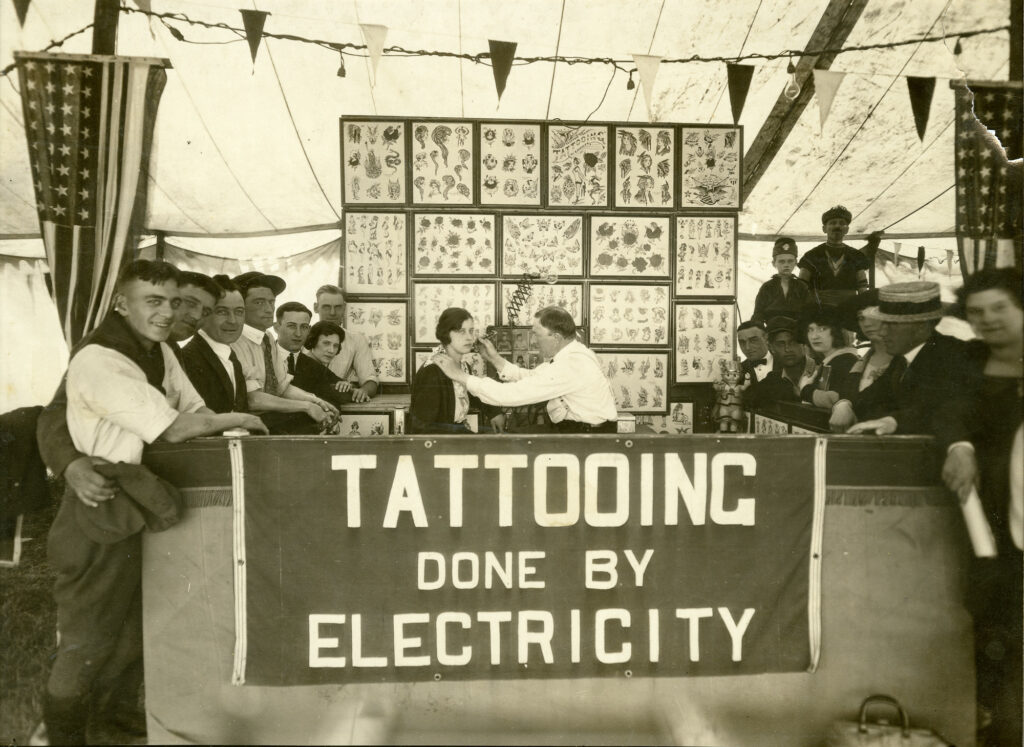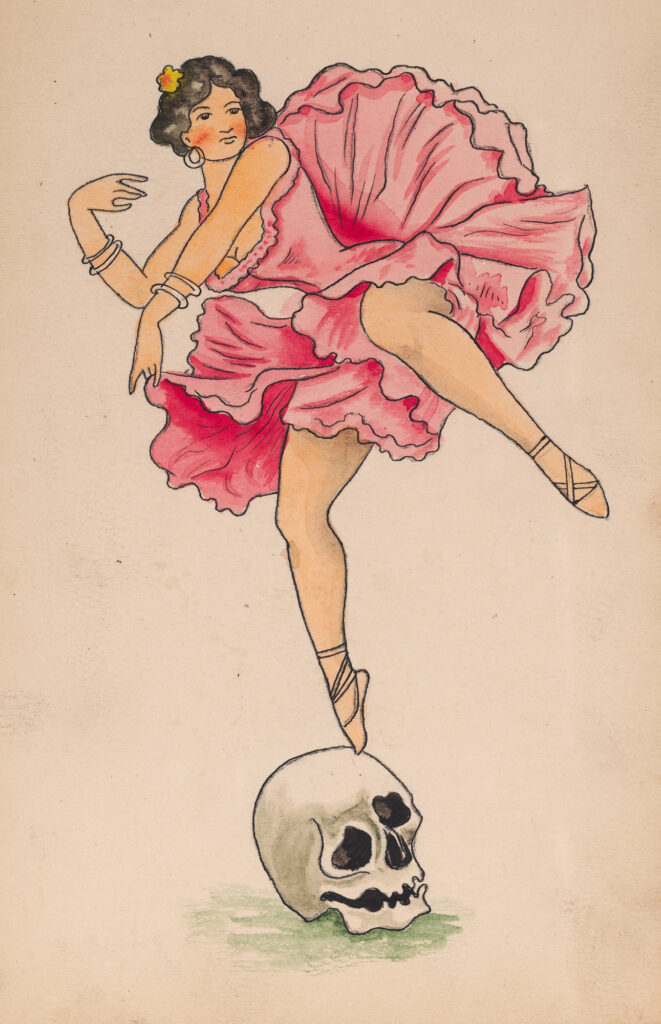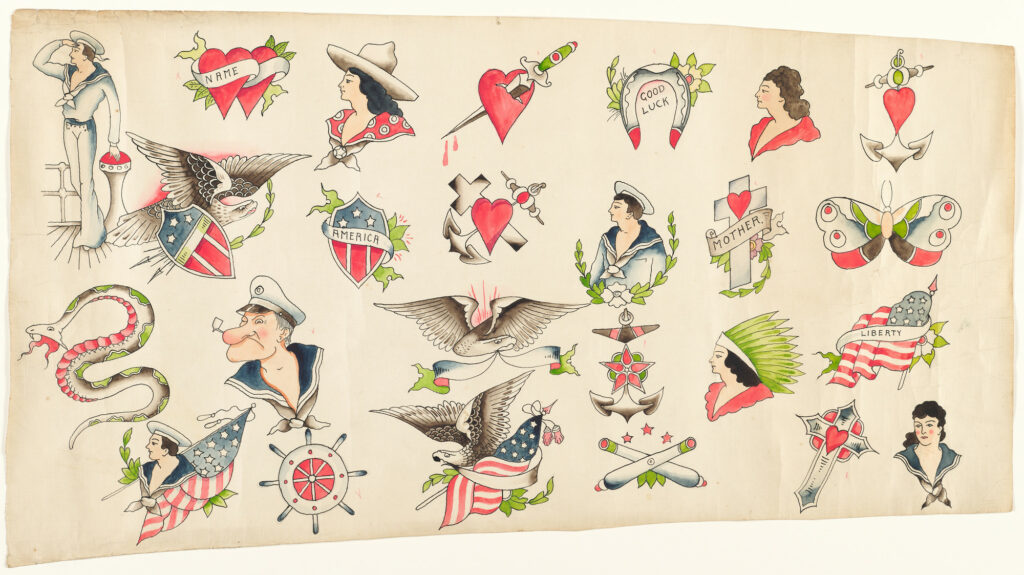 Eustis Estate
Eustis Estate
Dad Liberty
Tradition holds that Edward “Dad” Liberty (1883-1957) purchased his first tattoo kit from Frank Howard’s mail-order supply house in the early years of the twentieth century. During the next fifty years, Ed Liberty—together with his sons Frank, Harold, and Ted—dominated the Boston tattoo trade until the state of Massachusetts banned tattooing in 1962.
Over his long, successful tattooing career, Ed Liberty made a living for his family through blunt enterprise, adaptability, and a willingness to skirt the edges of middle-class social norms.
Ed took on the tattoo moniker “Dad” Liberty as his sons joined him in Scollay Square.
The Early Days

As young men, Ed Liberty and his brother Henry experimented with operating seasonal, low-overhead amusements to supplement their wage work. They ran bowling alleys, shooting galleries, small animal acts, and storefront shows featuring arcade games, peep shows, and exhibitions of small animals. Tattooed performers and itinerant tattooers were staples of these homegrown entertainment venues.
Ed Liberty purportedly entered the tattoo trade after a tattooer working at a family-owned shooting gallery skipped town, leaving his electric tattooing kit behind. By 1919, Ed was commuting to Boston to tattoo wherever he could find cheap workspace.
Edward W. Liberty’s Shooting Gallery Target
Lowell, Massachusetts, c. 1915
Collection of Nora Liberty White
Edward W. Liberty Tattooing Permanent Makeup at a Carnival
Edward W. Liberty Tattooing Permanent Makeup at a Carnival
Unidentified photographer
c. 1922
Collection of Nora Liberty White
During the summer season, Ed Liberty tattooed at traveling carnivals that were passing through New England. The spectacle of tattooing drew crowds of curious onlookers—and impulsive clients eager for adventure. Ed had this scene staged and photographed to promote his “cosmetic” tattooing for women, an effort to expand his clientele.

Edward W. Liberty Business Card
Boston, c. 1919
Collection of Historic New England
California and the Pacific Northwest
On a brief but formative trip to the West Coast in 1924-25, Ed met and worked with many notable early tattoo artists in Los Angeles and Seattle. He returned to Boston, where he occupied the iconic shop of Frank Howard, who had just died. The art and ephemera Ed acquired from these early West Coast sources formed the core of the large body of tattoo-related material he collected over his long career.

Edward W. Liberty in Los Angeles
Soldi Studio
Los Angeles, c. 1924
Image courtesy of Lillian Liberty Castell
 “Sailor” Carl Lindquist
“Sailor” Carl Lindquist
Previously owned by Edward W. Liberty
Unidentified photographer
Portland, Oregon, c. 1923
Enlargement of a real photo postcard
Collection of Jared Hook
Carl Lindquist’s tattoos were the work of West Coast tattoo artists George Fosdick and Bert Grimm. Colorful photo enlargements like this were popular decor in tattoo shops of the period. This particular example was discovered backing a framed sheet of tattoo flash.

Letter from Detroit Tattoo Artist and Supplier Percy Waters to Edward W. Liberty
25 December 1923
Collection of Nora Liberty White
Ed Liberty considered relocating to Detroit to ride out a major street-widening project in Scollay Square, which disrupted business for months. Percy Waters’s discouraging assessment of Detroit shop space may have been a factor in Ed’s decision to try his luck on the West Coast.
Making a Living
The son of French-Canadian immigrants, Edward Liberty grew up in the factory city of Lowell, Massachusetts, thirty miles northwest of Boston. The family ran a grocery store, and Ed and his brothers found wage work. Before taking up tattooing, Ed worked as a machinist in Cambridge, Massachusetts and Lowell. Mechanically gifted, he later used his skills to build tattoo machines.

Ed Liberty Tattooing Cassius E. Church
Unidentified photographer
Boston, c. 1929
Image courtesy of Lillian Liberty Castell
Ed Liberty created the largest and most complex work of his career on Cassius Ezra Church, an ex-Navy seaman who may have been preparing for a second career as a tattooed performer. Ed adorned Church’s chest and arms with patriotic and popular imagery. On Church’s back, Ed recreated a popular nineteenth-century genre painting of the Madonna and Child featuring billowing clouds and thirty-seven angels.

Dad’s Tattooing Studio Sign
Boston, 1930-50
Oil-based paint on wood
Collection of Robert Liberty

“Grandpa” Edward W. Liberty
Unidentified photographer
c. 1955
Image courtesy of Lillian Liberty Castell
Tattoo Designs with Popeye Cartoon
Tattoo Designs with Popeye Cartoon
Previously owned by Edward W. Liberty
Attributed to Frank Harrington (1886–1953)
1930-35 Ink and watercolor on paper
Collection of Jared Hook
Ed Liberty was among a small circle of tattoo artists who worked and at times even lived together. In 1923, Ed shared the same Boston address with tattooers Frank Harrington, Peter Jongeleen, and Ed Smith.

Patriotic “Chest Piece” Tattoo Design
Previously owned by Edward W. Liberty
Unidentified artist
1915-25
Ink and watercolor on board
Collection of Jared Hook
Edward W. Liberty Tattooing Sailor Roy Nordstrom
Edward W. Liberty Tattooing Sailor Roy Nordstrom of Walpole, Massachusetts
Wide World Photo
Boston, 1942
Image courtesy of Derin Bray
Click the spots to see the flash art in this gallery on the wall in the photograph.


to learn more

Examples of Tattoo Design Stencil Tracings (left) and Rubbings (right)
Previously owned by Edward W. Liberty
Unidentified artist
Boston, c. 1925
Ink on paper
Collection of Derin Bray

Directions For Care of a Tattoo Mark Which Has Been Removed
Edward W. Liberty
Boston, c. 1935
Collection of Historic New England


